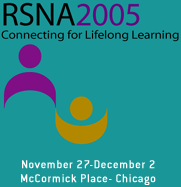
Abstract Archives of the RSNA, 2005
SSK04-04
Care of Chest Tubes Placed with Imaging Guidance: Importance of Proactive Radiology Service Involvement and a Physician Assistant
Scientific Papers
Presented on November 30, 2005
Presented as part of SSK04: ISP: Chest (Interventional Techniques)
Diane Alagno, Abstract Co-Author: Nothing to Disclose
Debra Ann Gervais MD, Presenter: Nothing to Disclose
Ronald Steven Arellano MD, Abstract Co-Author: Nothing to Disclose
Denise Palumbo, Abstract Co-Author: Nothing to Disclose
James Hunter Thrall MD, Abstract Co-Author: Nothing to Disclose
Peter Raff Mueller MD, Abstract Co-Author: Nothing to Disclose
To review our experience following incorporation of a physician assistant(PA)in the management of chest tubes placed by radiologists.
A PA was added to an interventional radiology service and assigned to manage chest tubes placed by radiologists following a one-month training period with direct supervision by radiologists. The setting was a general hospital where referring physician service and individual inpatient unit nursing expertise in chest tube management varies from extensive (thoracic surgery) to minimal (general medicine), resulting in varying compliance with radiologist orders and diverse levels of inpatient unit involvement in pleural effusion management. Adaptation of the PA to the new role and PA activity in patient management were monitored.
Over a 3-month period, 66 chest tubes were placed with CT or US guidance for malignancy, empyema/parapneumonic effusion, or failure/fluid overload. Routine management included placement of catheters to 20 cm H2O wall suction, monitoring of catheter input and output, and daily rounds by the radiology service and was overseen and directed by the physician assistant within 1 month. Average daily inpatient census of patients with chest tubes was 7. Proactive involvement by the PA included involvement in decision making regarding tube removal (all cases), prevention of early removal by the referring service intern (3), scheduling of additional imaging if needed to assess for undrained components or troubleshoot catheter problems (21), scheduling of additional tube placement (9), and initiation of adjunctive intrapleural thrombolytic therapy to drain loculated effusions (n = 3). The most frequent failure to comply with radiologist orders was the chest tube being on water seal when orders were in place for suction. This was typically because the patient had temporarily left the floor for testing with suction not resumed upon return. The PA corrected this oversight 15 times over 3 months.
Incorporation of a PA in management of chest tubes placed by radiologists is feasible and can be accomplished quickly with appropriate training. Patient care is enhanced by improving compliance with radiologist orders.
D.A.G.: Consultant for ValleyLab
Alagno, D,
Gervais, D,
Arellano, R,
Palumbo, D,
Thrall, J,
Mueller, P,
Care of Chest Tubes Placed with Imaging Guidance: Importance of Proactive Radiology Service Involvement and a Physician Assistant. Radiological Society of North America 2005 Scientific Assembly and Annual Meeting, November 27 - December 2, 2005 ,Chicago IL.
http://archive.rsna.org/2005/4415460.html

